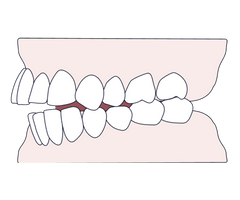Key takeaways:
What to expect
Initial consultation: You will discuss your concerns with a dentist or orthodontist.
Evaluation: The professional will conduct a thorough examination, which may include X-rays and other imaging, to create a custom treatment plan.
Treatment phase: Depending on the chosen option, this could involve wearing braces, aligners, or other devices for a period, typically ranging from one to three years or longer.
Regular adjustments: Throughout the process, you will have regular appointments for the orthodontist to monitor progress and make necessary adjustments to the appliance.
Maintenance phase: After active treatment is complete, you will need to wear retainers to keep the teeth from shifting back to their original position.
Important considerations
Adult vs. child treatment: Children may benefit from earlier treatment to guide jaw growth and may have shorter treatment times. Adult treatment is also effective but may take longer and cost more.
Impact on oral health: Successful treatment not only results in a straighter smile but also makes teeth easier to clean, which can reduce the risk of decay and improve overall oral health.
Duration: The length of treatment varies, but it is common for active treatment to last two to three years before a retainer is worn for maintenance.
Table of Content
-
What is malocclusion & why does it matter?
-
Classes of malocclusion
-
Types of malocclusion
-
What causes malocclusions?
-
What are the symptoms of malocclusions?
-
Malocclusion treatment options
-
What to expect during malocclusion treatment?
-
What to expect after treatment?
-
Potential risks or side effects
-
When to see an orthodontist?
-
Introducing Caspersmile Clear Aligners for treating malocclusion
-
Final thoughts: Straighten more than just your smile
-
FAQs
What is malocclusion & why does it matter?
Malocclusion is the clinical term for improperly aligned teeth that can cause oral health problems such as overbite, underbite, crossbite, and crowding. When teeth are misaligned, key oral functions such as chewing, biting, and speaking are difficult to perform properly. An orthodontist is specifically trained to treat any type of malocclusion and can work effectively to improve the alignment of your teeth in your jaw. Orthodontic treatment can involve several tools and techniques to shift the misaligned jaw and crooked teeth into the right positions.
Classes of malocclusion
Dentists and orthodontists classify malocclusion into three main categories, known as Angle's Classes. These classes describe how the upper and lower teeth align when the jaws are closed and help determine the right malocclusion treatment plan.
Class I malocclusion: Normal bite with misaligned teeth
Class I malocclusion is the most common type. In this condition, the upper and lower jaws are properly aligned, but individual teeth may be crowded, rotated, or spaced irregularly.
Even though the bite is technically “normal,” dental malocclusion issues like overlapping teeth, minor gaps, or slight rotation can still affect appearance and oral hygiene. If untreated, these issues may lead to plaque buildup, cavities, or gum disease.
Class II malocclusion: Retrognathism or overbite
Class II malocclusion, also called retrognathism, occurs when the upper teeth and jaw significantly overlap the lower teeth. This results in a pronounced overbite and sometimes gives the appearance of a receding chin.
This type is often genetic but can also be influenced by habits like thumb-sucking during childhood. Class II can range from mild to severe and may cause issues with chewing, speech, and jaw comfort.
Class III malocclusion: Prognathism or underbite
Class III malocclusion, known as prognathism, happens when the lower teeth and jaw extend forward past the upper teeth, creating an underbite malocclusion. This misalignment is often due to an enlarged lower jaw or a smaller upper jaw.
Patients with Class III malocclusion may experience difficulty biting, chewing, and speaking clearly. The condition can also affect facial balance, making the lower jaw appear more prominent.
Types of malocclusion

Understanding the type of malocclusion you have helps determine the right course of treatment. Here are the most common types:
Overbite (Malocclusion overbite)
Occurs when the upper front teeth excessively overlap the lower teeth. Severe overbites can cause tooth wear, gum damage, and speech problems.
Underbite
The lower teeth extend past the upper teeth, often resulting from a misaligned jaw or genetic factors. It can lead to chewing difficulties and jaw discomfort.
Crossbite
Some upper teeth sit inside the lower teeth when you bite down. This uneven alignment can affect jaw growth in children and cause asymmetric wear in adults.
Open Bite
When the front teeth don't touch, even when the back teeth are closed. Often linked to thumb-sucking or tongue thrusting habits, it can cause speech issues.
Crowding
Teeth overlap because there isn't enough space in the jaw. Crowding makes cleaning difficult and increases the risk of cavities and gum disease.
Spacing
Gaps between teeth due to missing teeth or jaw-size mismatch. It may cause aesthetic concerns and affect bite stability.
Think you might have a malocclusion?
Don't wait for it to worsen. Take our quick online assessment today and discover the best treatment options tailored just for you!

What causes malocclusions?
Most of the time, malocclusions are inherited. This generational passed-on dental condition can also be caused due to habits that can change the jaw structure and shape. One of the most common causes is little to no room for teeth eruption. Other causes of malocclusion are:
-
Thumb sucking
-
Prolonged pacifier usage
-
Cleft palate and lips
-
Lack of proper oral hygiene
-
Trauma and injuries
-
Mouth tumors
-
Airway obstruction due to allergies or enlarged adenoids
-
Feeding from a bottle
-
Impacted tooth
What are the symptoms of malocclusions?
The symptoms depend on the type of malocclusion you are suffering. They range from mild to severe and include:
-
Speech difficulties
-
Misaligned teeth
-
Chewing or biting difficulties
-
Mouth breathing problems
-
Biting cheeks or tongue
-
Facial structure change
Malocclusion treatment options

Depending on the type and severity of your case, malocclusion treatment can involve orthodontic devices, surgical procedures, or sometimes a combination of both. Below, we break down the main approaches used to treat dental malocclusion effectively.
Orthodontic treatments
Orthodontic treatments are the most common approach to correcting malocclusion of the jaw. They work by applying gentle, continuous pressure that gradually shifts teeth and jaws into their proper position. The treatment plan depends on your specific bite issue, age, and the degree of misalignment.
Braces
The most traditional and effective method for correcting complex cases of malocclusion teeth. They offer precise control over tooth movement and are suitable for patients of all ages.
-
Traditional metal braces: Made of stainless steel, these are highly durable and ideal for correcting significant crowding, spacing, or bite misalignment.
-
Ceramic braces: Designed with tooth-colored brackets for a less noticeable appearance, these are a popular choice among teens and adults who want discreet treatment.
-
Lingual braces: Attached to the inner surface of the teeth, lingual braces are nearly invisible from the outside, offering aesthetic appeal without compromising performance.
Each type of braces has unique benefits, and your orthodontist will recommend the best option based on your dental needs and lifestyle.
Clear Aligners
For those seeking a modern and flexible way to straighten their teeth, clear aligners offer an ideal and hassle-free solution. These transparent, removable trays are suitable for mild to moderate malocclusion treatment.
Clear aligners work by applying consistent, gentle pressure to move your teeth into proper alignment. Unlike braces, they can be taken out for eating, brushing, and special occasions, making them one of the most convenient options for adults and professionals. They're nearly invisible, comfortable, and customized for your smile.
Struggling with malocclusion?
Skip the metal braces, choose clear aligners, and straighten your teeth comfortably, discreetly, and affordably from the comfort of home!

Palate expanders
In children and adolescents, palate expanders are often used to address early bite issues such as crossbites or overcrowding. This orthodontic device gradually widens the upper jaw, creating more space for permanent teeth to erupt naturally and preventing future misalignment. Early intervention with palate expanders can often eliminate the need for more extensive treatments later in life.
Retainers
After completing orthodontic treatment, retainers play a crucial role in maintaining results. Teeth naturally have a tendency to shift back into their previous positions, but wearing retainers as prescribed ensures your bite remains properly aligned. Depending on your case, your orthodontist may recommend fixed or removable retainers to preserve the results of your malocclusion treatment.
Your new smile deserves protection.
Get your clear retainers now and maintain perfectly aligned teeth without any hassle!

Habit appliances
In some children, habits such as thumb-sucking or tongue thrusting can contribute to malocclusion symptoms such as open bites or overbites. Habit appliances are specially designed to discourage these behaviors and support normal jaw and dental development. Early correction prevents long-term bite problems and promotes healthier oral growth.
Surgical treatments
In cases where jaw misalignment treatment requires structural correction beyond what braces or aligners can achieve, surgery may be recommended. Surgical treatments are typically reserved for adults or patients with fully developed jaws where skeletal discrepancies are significant.
Orthognathic (Jaw) surgery
Orthognathic surgery is a corrective procedure that repositions the upper, lower, or both jaws to achieve proper bite alignment and facial balance. This form of misaligned jaw treatment is often combined with orthodontic therapy for the best functional and aesthetic outcome.
The surgery can improve chewing efficiency, speech clarity, and overall facial symmetry. It may also help alleviate related conditions such as chronic jaw pain, temporomandibular joint (TMJ) disorders, and sleep apnea. Thanks to modern imaging and surgical techniques, orthognathic surgery is safer and more precise than ever before, with faster recovery times.
Tooth extraction
In certain cases of dental malocclusion involving overcrowded teeth, tooth extraction may be necessary to create enough space for alignment. This step is often performed before starting braces or aligner treatment. While extraction may sound intimidating, it's a routine and safe procedure that allows the remaining teeth to shift into their correct positions, promoting a healthier, more balanced bite.
What to expect during malocclusion treatment?
Whether you're starting braces, aligners, or jaw misalignment treatment, knowing what to expect helps you prepare for every stage.
Initial consultation
Your orthodontist begins by evaluating your malocclusion symptoms and bite pattern through:
-
A physical exam of your teeth and jaw.
-
X-rays, 3D scans, or impressions to assess structure.
-
A personalized treatment plan detailing expected time, tools, and cost.
Treatment implementation
-
Braces: Expect mild soreness after tightening sessions. Avoid sticky, hard foods and follow oral hygiene instructions.
-
Aligners: You'll switch trays every 1-2 weeks. Wearing them 20-22 hours daily ensures results.
-
Surgery: Carried out under anesthesia; recovery involves a soft diet and gradual return to normal activity.
Ongoing monitoring
Regular checkups track progress, make adjustments, and ensure alignment is moving as planned.
What to expect after treatment?
Finishing your treatment doesn't mean the process is over; retention and recovery are crucial to maintain your new bite alignment.
Retention phase
After malocclusion treatment, retainers keep your teeth in their corrected positions. You may need to wear them full-time for several months, then only at night.
Jaw surgery recovery
Post-surgical recovery includes mild swelling or stiffness. Most patients return to normal function within 6-8 weeks, with full healing taking a few months.
Long-term results
With consistent care, you'll enjoy:
-
Proper bite alignment.
-
Improved speech and chewing.
-
Reduced tooth wear and jaw tension.
-
A confident, lasting smile.
Potential risks or side effects
Though generally safe, malocclusion treatments can cause temporary effects:
-
Minor tooth sensitivity.
-
Gum irritation or soreness.
-
Mild discomfort after adjustments.
-
Rarely, root resorption (shortened tooth roots) occurs during long treatments.
Your orthodontist will monitor your progress and adjust your plan as needed.
When to see an orthodontist?
You should consult a specialist if you experience:
-
Difficulty biting or chewing.
-
Speech issues or jaw pain.
-
Teeth grinding or clicking jaws.
-
Crooked or gapped teeth.
Early detection, especially in children, makes treatment simpler and more effective.
Introducing Caspersmile Clear Aligners for treating malocclusion

Caspersmile Clear Aligners offer a modern, comfortable, and nearly invisible solution for correcting mild to moderate malocclusion. Designed with precision technology, these custom-fit trays gently move your teeth into perfect alignment, without the discomfort of wires or brackets. Whether you're dealing with crowding, spacing, or a minor bite issue, Caspersmile Clear Aligners makes achieving a confident, straight smile easier and more affordable than ever.
How does it work?
Here's a breakdown of how Caspersmile Clear Aligner works:

Final thoughts: Straighten more than just your smile
Malocclusion affects far more than appearance; it can influence how you eat, speak, and feel about your smile. Modern orthodontics and misaligned jaw treatment techniques make correction easier, more comfortable, and more precise than ever before. From traditional braces to innovative options like Caspersmile Clear Aligners, you can choose a treatment that fits your lifestyle and needs. Caspersmile's invisible, removable trays offer a discreet and effective way to align your teeth, boost confidence, and protect long-term oral health, helping you achieve not just a straighter smile, but a healthier, happier you.
Frequently asked questions

References
American Orthodontic Society. Identifying and Treating Malocclusions Classes I, II, and III
(https://orthodontics.com/identifying-and-treating-malocclusions-classes/). Last updated 3/1/2022. Accessed 10/28/2024.
Cenzato N, Nobili A, Maspero C. Prevalence of Dental Malocclusions in Different Geographical Areas: Scoping Review
(https://pmc.ncbi.nlm.nih.gov/articles/PMC8534899/). Dent J (Basel). 2021 Oct 11;9(10):117. Accessed 10/28/2024.
De Ridder L, Aleksieva A, Willems G, Declerck D, Cadenas de Llano-Pérula M. Prevalence of Orthodontic Malocclusions in
Healthy Children and Adolescents: A Systematic Review (https://pubmed.ncbi.nlm.nih.gov/35742703/). Int J Environ Res
Public Health. 2022 Jun 17;19(12):7446. Accessed 10/28/2024.
Subscribe our newsletter
By clicking subscribe, you agree to our Privacy Policy and opt in to receive communications from Caspersmile. You can unsubscribe at any time.





